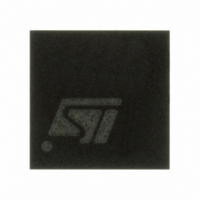ST7FLITE39F2U6 STMicroelectronics, ST7FLITE39F2U6 Datasheet - Page 113

ST7FLITE39F2U6
Manufacturer Part Number
ST7FLITE39F2U6
Description
IC MCU 8BIT 8K FLASH 20QFN
Manufacturer
STMicroelectronics
Series
ST7r
Datasheet
1.ST7FLITE35F2M6TR.pdf
(173 pages)
Specifications of ST7FLITE39F2U6
Core Processor
ST7
Core Size
8-Bit
Speed
16MHz
Connectivity
LINSCI, SPI
Peripherals
LVD, POR, PWM, WDT
Number Of I /o
15
Program Memory Size
8KB (8K x 8)
Program Memory Type
FLASH
Eeprom Size
256 x 8
Ram Size
384 x 8
Voltage - Supply (vcc/vdd)
2.7 V ~ 5.5 V
Data Converters
A/D 7x10b
Oscillator Type
Internal
Operating Temperature
-40°C ~ 85°C
Package / Case
20-QFN
For Use With
497-8406 - BOARD STF20NM50FD/STF7LITE39BF2497-8403 - BOARD DEMO STCC08 AC SW DETECTOR497-6398 - BOARD EVAL ST7FLITE39/STM1403497-5858 - EVAL BOARD PLAYBACK ST7FLITE497-5514 - EVAL BOARD THERMO CONTROL REFRIG497-5049 - KIT STARTER RAISONANCE ST7FLITE
Lead Free Status / RoHS Status
Lead free / RoHS Compliant
Other names
497-5635
Available stocks
Company
Part Number
Manufacturer
Quantity
Price
- Current page: 113 of 173
- Download datasheet (3Mb)
LINSCI™ SERIAL COMMUNICATION INTERFACE (LIN Mode) (cont’d)
11.5.9.7 LINSCI Clock Tolerance
LINSCI Clock Tolerance when unsynchronized
When LIN slaves are unsynchronized (meaning no
characters have been transmitted for a relatively
long time), the maximum tolerated deviation of the
LINSCI clock is +/-15%.
If the deviation is within this range then the LIN
Synch Break is detected properly when a new re-
ception occurs.
This is made possible by the fact that masters
send 13 low bits for the LIN Synch Break, which
can be interpreted as 11 low bits (13 bits -15% =
11.05) by a “fast” slave and then considered as a
LIN Synch Break. According to the LIN specifica-
tion, a LIN Synch Break is valid when its duration
is greater than t
LIN Synch Break must last at least 11 low bits.
Note: If the period desynchronization of the slave
is +15% (slave too slow), the character “00h”
which represents a sequence of 9 low bits must
not be interpreted as a break character (9 bits +
15% = 10.35). Consequently, a valid LIN Synch
break must last at least 11 low bits.
LINSCI Clock Tolerance when Synchronized
When synchronization has been performed, fol-
lowing reception of a LIN Synch Break, the LINS-
CI, in LIN mode, has the same clock deviation tol-
erance as in SCI mode, which is explained below:
During reception, each bit is oversampled 16
times. The mean of the 8th, 9th and 10th samples
is considered as the bit value.
Figure 64.Bit Sampling in Reception Mode
RDI LINE
Sample
clock
SBRKTS
1
= 10. This means that the
2
3
4
7/16
5
6
7
sampled values
Consequently, the clock frequency should not vary
more than 6/16 (37.5%) within one bit.
The sampling clock is resynchronized at each start
bit, so that when receiving 10 bits (one start bit, 1
data byte, 1 stop bit), the clock deviation should
not exceed 3.75%.
11.5.9.8 Clock Deviation Causes
The causes which contribute to the total deviation
are:
All the deviations of the system should be added
and compared to the LINSCI clock tolerance:
D
8
One bit time
TRA
– D
– D
– D
– D
– D
Note: The transmitter can be either a master
or a slave (in case of a slave listening to the
response of another slave).
ment performed by the receiver.
tion of the receiver.
receiver: This deviation can occur during the
reception of one complete LIN message as-
suming that the deviation has been compen-
sated at the beginning of the message.
(generally due to the transceivers)
9
+ D
TRA
MEAS
QUANT
REC
TCL
: Deviation due to the transmission line
MEAS
: Deviation due to transmitter error.
: Deviation of the local oscillator of the
10
: Error due to the LIN Synch measure-
: Error due to the baud rate quantiza-
+D
11
QUANT
12
+ D
13
6/16
7/16
REC
14
+ D
ST7LITE3xF2
15
TCL
< 3.75%
16
113/173
Related parts for ST7FLITE39F2U6
Image
Part Number
Description
Manufacturer
Datasheet
Request
R

Part Number:
Description:
KIT STARTER RAISONANCE ST7FLITE
Manufacturer:
STMicroelectronics
Datasheet:

Part Number:
Description:
STMicroelectronics [RIPPLE-CARRY BINARY COUNTER/DIVIDERS]
Manufacturer:
STMicroelectronics
Datasheet:

Part Number:
Description:
STMicroelectronics [LIQUID-CRYSTAL DISPLAY DRIVERS]
Manufacturer:
STMicroelectronics
Datasheet:

Part Number:
Description:
BOARD EVAL FOR MEMS SENSORS
Manufacturer:
STMicroelectronics
Datasheet:

Part Number:
Description:
NPN TRANSISTOR POWER MODULE
Manufacturer:
STMicroelectronics
Datasheet:

Part Number:
Description:
TURBOSWITCH ULTRA-FAST HIGH VOLTAGE DIODE
Manufacturer:
STMicroelectronics
Datasheet:

Part Number:
Description:
Manufacturer:
STMicroelectronics
Datasheet:

Part Number:
Description:
DIODE / SCR MODULE
Manufacturer:
STMicroelectronics
Datasheet:

Part Number:
Description:
DIODE / SCR MODULE
Manufacturer:
STMicroelectronics
Datasheet:

Part Number:
Description:
Search -----> STE16N100
Manufacturer:
STMicroelectronics
Datasheet:

Part Number:
Description:
Search ---> STE53NA50
Manufacturer:
STMicroelectronics
Datasheet:

Part Number:
Description:
NPN Transistor Power Module
Manufacturer:
STMicroelectronics
Datasheet:











